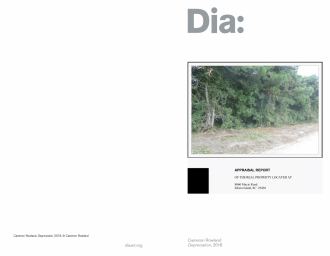Cameron Rowland, Depreciation
Restrictive covenant; 1 acre on Edisto Island, South Carolina

Cameron Rowland, Depreciation, 2018. © Cameron Rowland
Overview
Cameron Rowland
Depreciation, 2018
Restrictive covenant; 1 acre on Edisto Island, South Carolina
Extended loan, Dia Art Foundation
40 acres and a mule as reparations for slavery originates in General William Tecumseh Sherman’s Special Field Orders No. 15, issued on January 16, 1865. Sherman’s Field Order 15 was issued out of concern for a potential uprising of the thousands of ex-slaves who were following his army by the time it arrived in Savannah.1
The field order stipulated that “The islands from Charleston south, the abandoned rice fields along the rivers for thirty miles back from the sea, and the country bordering the St. Johns River, Florida, are reserved and set apart for the settlement of the negroes now made free by the acts of war and the Proclamation of the President of the United States. . . . Each family shall have a plot of not more than forty acres of tillable ground.”2
This was followed by the formation of the Bureau of Refugees, Freedmen, and Abandoned Lands in March 1865. In the months immediately following the issue of the field orders, approximately 40,000 former slaves settled in the area designated by Sherman on the basis of possessory title.3 10,000 of these former slaves were settled on Edisto Island, South Carolina.4
In 1866, following Lincoln’s assassination, President Andrew Johnson effectively rescinded Field Order 15 by ordering these lands be returned to their previous Confederate owners. Former slaves were given the option to work for their former masters as sharecroppers or be evicted. If evicted, former slaves could be arrested for homelessness under vagrancy clauses of the Black Codes. Those who refused to leave and refused to sign sharecrop contracts were threatened with arrest.
Although restoration of the land to the previous Confederate owners was slowed in some cases by court challenges filed by ex-slaves, nearly all the land settled was returned by the 1870s. As Eric Foner writes, “Johnson had in effect abrogated the Confiscation Act and unilaterally amended the law creating the [Freedmen’s] Bureau. The idea of a Freedmen’s Bureau actively promoting black landownership had come to an abrupt end.”5 The Freedmen’s Bureau agents became primary proponents of labor contracts inducting former slaves into the sharecropping system.6
Among the lands that were repossessed in 1866 by former Confederate owners was the Maxcy Place plantation. “A group of freed people were at Maxcy Place in January 1866. . . . The people contracted to work for the proprietor, but no contract or list of names has been found.”7
The one-acre piece of land at 8060 Maxie Road, Edisto Island, South Carolina, was part of the Maxcy Place plantation. This land was purchased at market value on August 6, 2018, by 8060 Maxie Road, Inc., a nonprofit company formed for the sole purpose of buying this land and recording a restrictive covenant on its use. This covenant has as its explicit purpose the restriction of all development and use of the property by the owner.
The property is now appraised at $0. By rendering it legally unusable, this restrictive covenant eliminates the market value of the land. These restrictions run with the land, regardless of the owner. As such, they will last indefinitely.
As reparation, this covenant asks how land might exist outside of the legal-economic regime of property that was instituted by slavery and colonization. Rather than redistributing the property, the restriction imposed on 8060 Maxie Road’s status as valuable and transactable real estate asserts antagonism to the regime of property as a means of reparation.
8060 Maxie Road is not for visitation.
notes
1 Eric Foner, Reconstruction: America’s Unfinished Revolution, 1863–1877, updated ed. (New York: Harper & Row, 1988; New York: HarperCollins, 2014), p. 71.
2 Headquarters, Military Division of the Mississippi, Special Field Orders No. 15 (1865).
3 Foner, Reconstruction, p. 71.
4 Charles Spencer, Edisto Island 1861 to 2006: Ruin, Recovery and Rebirth (Charleston, SC: The History Press, 2008), p. 87.
5 Foner, Reconstruction, p. 161.
6 Foner, p. 161.
7 Spencer, Edisto Island 1861 to 2006, p. 95.
Artist
Cameron Rowland
(1988)
Cameron Rowland was born in Philadelphia in 1988. They live in New York.
